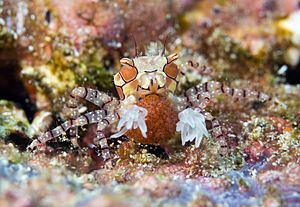Lybia edmondsoni facts for kids
Quick facts for kids Lybia edmondsoni |
|
|---|---|
 |
|
| Scientific classification | |
| Kingdom: | |
| Phylum: | |
| Subphylum: | |
| Class: | |
| Order: | |
| Infraorder: | |
| Family: |
Xanthidae
|
| Genus: | |
| Species: |
L. edmondsoni
|
| Binomial name | |
| Lybia edmondsoni Takeda & Miyake, 1970
|
|
The Lybia edmondsoni is a small and unique type of crab. It belongs to the Xanthidae family. You can only find this special crab in the Hawaiian Islands.
People often call it the pom-pom crab or boxer crab. This is because it carries a sea anemone in each of its front claws. These anemones look a lot like cheerleading pom-poms or tiny boxing gloves! In Hawaii, its name is kūmimi pua, which means "inedible flower crab." Long ago, some people in Hawaii who said they were sorcerers used this animal.
Contents
Discovering the Pom-Pom Crab
This crab has a shell, called a carapace, that can grow up to about 1.3 centimeters (0.5 inches) wide. Its shell often has cool patterns in pink, brown, or yellow.
Unlike most crabs, its front claws (called chelipeds) are not very strong. They are delicate and can bend easily. The crab also has several spines pointing backward. Its walking legs have dark purple stripes. When this crab is on sand or small rocks, it's almost impossible to see! It blends in perfectly with its surroundings.
The name "pom-pom crab" comes from how it uses stinging sea anemones. It holds an anemone, usually Triactis producta, in each claw. It uses them to defend itself from animals that want to eat it. It might also use them to stun its prey. The name "boxer crab" comes from how it acts tough when it feels threatened.
Where Do Boxer Crabs Live?
L. edmondsoni lives only in Hawaii. However, it looks and acts very much like its close relative, L. tessellata. That crab lives in many tropical parts of the Indo-Pacific Ocean.
You can find L. edmondsoni in shallow ocean water. They live down to about 20 meters (65 feet) deep. These crabs like to hide under rocks or among pieces of coral. They also live on sandy or gravelly areas where their colors help them hide. Sometimes, you can even spot them clinging to live corals with their long, thin legs.
How Boxer Crabs Live and Grow
L. edmondsoni crabs have weak claws. This means they can't defend themselves or catch food very well on their own. They hold the sea anemones gently with their claws. Small spines help keep the anemones in place.
The crabs use the anemones for defense. But they also get food from them! The anemones use their tentacles to catch tiny food bits. The crab then scrapes these food particles off the anemones for its own meal.
When these crabs molt (shed their old shell to grow), it often happens at night. By morning, even though their new shell is still soft, they have already grabbed their anemones again!
How Boxer Crabs Get New Anemones
The sea anemone T. producta can make copies of itself by splitting in half. Scientists have studied this amazing behavior. They found that if a crab only had one anemone, or if one was taken away, it would soon have a partial anemone in each claw. These partial anemones would then grow into full ones!
One time, a scientist saw a crab actually pull an anemone in half. The crab held the anemone with both claws and pulled them apart until the anemone split. This is how they make sure they always have two "pom-poms"!
Boxer Crab Behavior
In 1905, a scientist named James Edwin Duerden studied how boxer crabs and their sea anemones work together. He looked at which anemones they chose, how they got them, how they used them, and how both the crabs and anemones ate. His work is still very important for understanding this special partnership.
More recently, in 1997, other scientists studied how these crabs act when they meet other crabs of the same kind. They wanted to know if the crabs used their anemones as weapons during these meetings.
Most of the crabs in the study had two anemones when they were caught. When two crabs met, they often started their "fight" from a distance. They would stretch out a leg holding an anemone towards the other crab as a threat. Some crabs would back away at this point.
If they did touch, they would grapple with their back legs. The anemones were held out of the way, behind the crabs. Scientists wondered why the crabs didn't use their stinging anemones in these fights. They came up with a few ideas:
- Maybe the anemone is very poisonous to other crabs, and the crab doesn't want to hurt itself by using it.
- Maybe the anemone isn't poisonous to other crabs, so using it would be pointless.
- Perhaps the anemone is so important to the crab that it doesn't want to risk losing or damaging it in a fight.
Even with more research, scientists haven't fully figured out which idea is correct.
The way these crabs fight is mostly like a dance. There's a lot of waving their "weapons" (anemones), but not much actual touching. The anemone is clearly very important to the crab. But what does the anemone get out of it? It might get more food and oxygen because the crab moves it around. It also avoids getting buried in shifting sand.
In 2017, another study confirmed that boxer crabs missing an anemone will tear their other one in half. They also saw crabs stealing anemone pieces from other boxer crabs! The torn anemones quickly grow back to their normal size. This helps explain why almost all wild boxer crabs, even young ones, carry two anemones.



